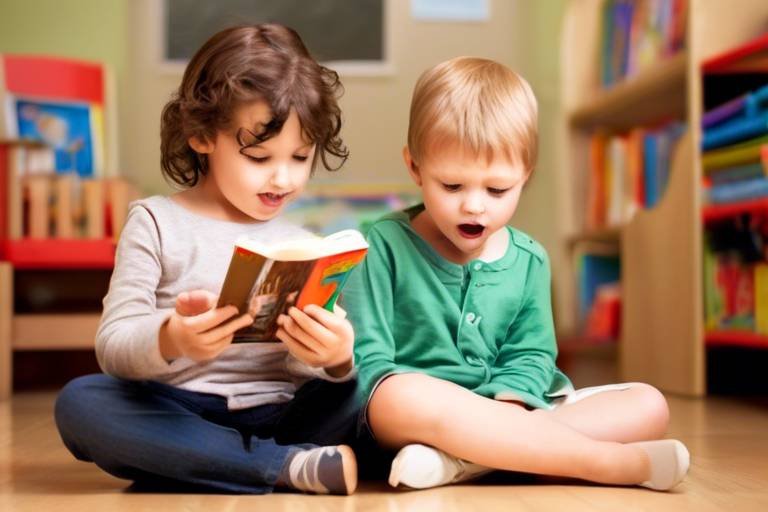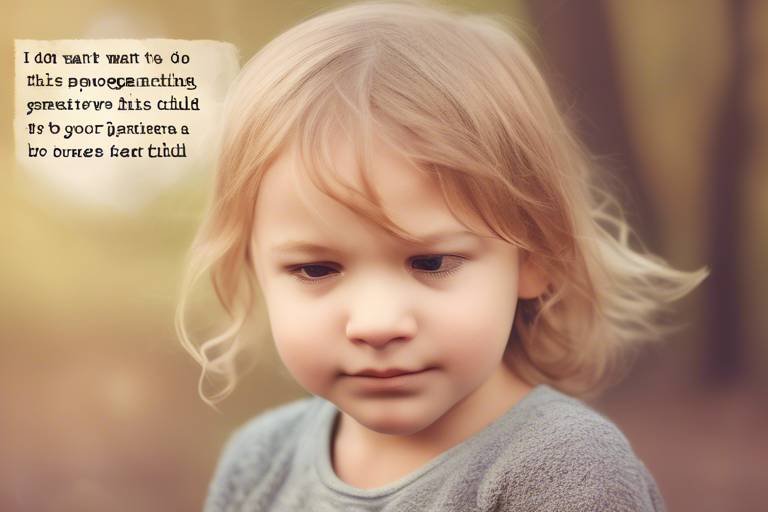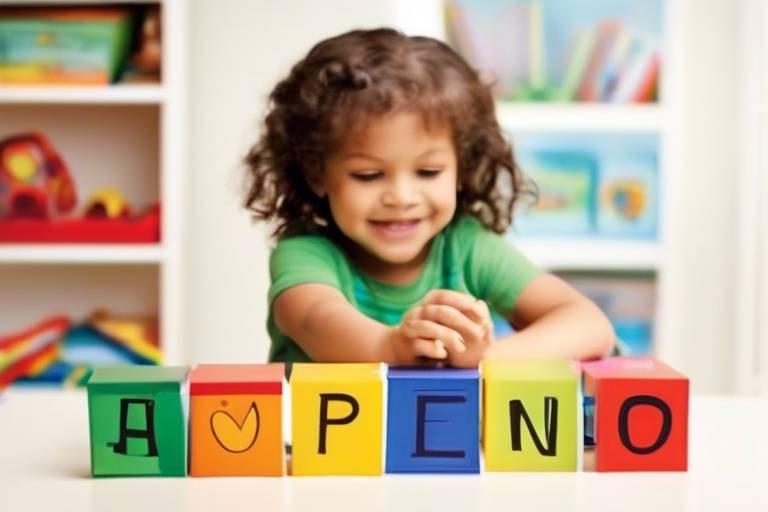Ways To Encourage Positive Behavior In Children
Encouraging positive behavior in children is not just about correcting missteps; it’s about nurturing their growth and development in a way that feels supportive and engaging. Imagine a garden where each child is a unique flower. To help them bloom, they need the right mix of sunlight, water, and nutrients. Similarly, children thrive in an environment rich with encouragement, understanding, and positive reinforcement. In this article, we will explore effective strategies that can transform the way we interact with children, fostering an atmosphere where good behavior is not only expected but celebrated.
Before we dive into specific strategies, it's essential to understand the different stages of child development. Just like a book unfolds its story chapter by chapter, children grow and evolve in their cognitive, emotional, and social capabilities. Recognizing these stages allows parents and educators to tailor their approaches effectively. For instance, toddlers are often egocentric and may not grasp the concept of sharing, while older children are beginning to understand empathy and cooperation. By aligning our strategies with their developmental needs, we can better support their journey toward positive behavior.
One of the most effective ways to shape behavior is through positive reinforcement. Think of it as giving a high-five to good behavior; it makes the child feel appreciated and motivates them to repeat that behavior. Positive reinforcement can take several forms, and understanding these can help parents and teachers choose the best methods to encourage desirable actions consistently.
When it comes to rewards, variety can be the spice of life. Here are some types of rewards that can be effective:
- Tangible Rewards: These are physical items, like stickers or small toys, that children can earn for good behavior.
- Verbal Rewards: Simple praise or encouragement can go a long way in boosting a child's confidence.
- Experiential Rewards: Activities like a trip to the park or a special movie night can create lasting memories and motivate children.
Verbal praise is one of the most immediate and impactful ways to reinforce good behavior. When you acknowledge a child's efforts with specific and genuine compliments, it not only boosts their self-esteem but also fuels their motivation. For example, instead of saying, “Good job,” try being more specific: “I really liked how you helped your sister with her homework. That was very kind of you!” This kind of feedback helps children understand exactly what behaviors are being rewarded, making it more likely they'll repeat those actions.
Tangible rewards can also serve as effective motivators. Items like stickers, small toys, or even a special treat can be enticing for children. However, it’s crucial to use these rewards appropriately. They should be used to reinforce specific behaviors rather than as a bribe. For instance, if a child completes their chores without being asked, offering a sticker can reinforce that behavior positively. The key is to ensure that these rewards are used sparingly and are tied directly to the desired behavior.
A supportive environment is the bedrock of encouraging good behavior. This means creating spaces—both at home and at school—that foster respect, understanding, and cooperation. Simple actions, like maintaining a clean and organized space or using positive language, can significantly impact a child’s behavior. When children feel safe and valued, they are more likely to exhibit positive behaviors. Additionally, setting up routines can help children know what to expect, reducing anxiety and promoting good behavior.
Establishing clear expectations is vital in helping children understand what behaviors are desired. Communication is key here. When you explain the rules and guidelines in a way that children can understand, it sets a foundation for good behavior. Consistency is equally important—children thrive on routine and knowing what is expected of them.
Consistency in enforcing rules helps children internalize expectations and develop self-discipline. Imagine trying to play a game where the rules change every time you play; it would be confusing and frustrating! By consistently applying the same rules, children learn to navigate their environment more effectively and understand the consequences of their actions.
Involving children in the process of setting rules fosters a sense of ownership and accountability. When children have a say in the rules that govern their behavior, they are more likely to adhere to them. This collaborative approach not only empowers children but also teaches them valuable lessons about responsibility and teamwork.
Children are keen observers, and they learn a lot by watching the adults around them. This is why modeling positive behavior is crucial. When adults demonstrate kindness, patience, and respect, children are likely to mirror these actions. Think of yourself as a lighthouse; your behavior illuminates the path for children to follow. Whether it’s resolving conflicts calmly or showing appreciation for others, your actions speak volumes and can have a lasting impact on their behavior.
Q: How can I effectively use praise without overdoing it?
A: The key is to be specific and genuine. Instead of general praise, focus on particular actions that you want to encourage.
Q: What if my child responds negatively to rewards?
A: Some children may not respond well to tangible rewards. In such cases, focus more on verbal praise or experiential rewards, and always ensure that the rewards align with their interests.
Q: How can I help my child understand the importance of rules?
A: Involve them in the rule-making process and explain the reasons behind each rule. This helps them see the value in following them.

Understanding Child Development
This article explores effective strategies for fostering positive behavior in children, emphasizing the importance of encouragement, reinforcement, and understanding developmental needs to create a supportive environment for growth.
Recognizing the stages of child development is crucial for parents and educators alike. Children, like a garden, need the right conditions to thrive. As they grow, their cognitive, emotional, and social skills evolve in ways that influence how they interact with the world around them. Understanding these stages can significantly inform the strategies we use to encourage positive behavior. For instance, a toddler's brain is like a sponge, soaking up information and experiences, while a school-aged child begins to develop a sense of independence and social awareness.
Developmental milestones can be categorized into several key areas, including:
- Cognitive Development: This includes how children think, explore, and figure things out. It involves problem-solving and understanding concepts.
- Emotional Development: This aspect focuses on how children understand their own feelings and those of others, helping them build empathy.
- Social Development: This is about how children interact with others, form relationships, and navigate social situations.
By understanding these areas, parents and educators can tailor their approaches to fit the child's developmental stage. For example, toddlers may respond better to simple instructions and immediate feedback, while older children might appreciate discussions about their behavior and its consequences. It's essential to remember that every child is unique, and their development can vary widely.
Moreover, the environment plays a vital role in shaping a child's development. A nurturing, supportive atmosphere can promote healthy growth, while a chaotic or stressful environment can hinder it. Therefore, creating a safe space where children feel comfortable expressing themselves is essential for fostering positive behavior. Just like a plant needs sunlight and water, children need love, attention, and guidance to flourish.
In summary, understanding child development is not just about recognizing milestones; it's about appreciating the intricate dance of growth that each child experiences. By being aware of their developmental needs, we can better support them in exhibiting positive behaviors and becoming well-rounded individuals.
Positive reinforcement is a powerful tool in shaping behavior. This section discusses various techniques, such as praise and rewards, that can motivate children to exhibit desired behaviors consistently.
Exploring different types of rewards—tangible, verbal, and experiential—can help parents and teachers choose the most effective methods to reinforce positive behavior in children.
Verbal praise is an immediate and impactful way to reinforce good behavior. This subsection highlights how specific and genuine acknowledgment can boost a child's self-esteem and motivation.
Tangible rewards, such as stickers or small gifts, can serve as effective motivators. This section examines how to use these rewards appropriately to encourage ongoing positive behavior.
A supportive environment is essential for encouraging good behavior. This section outlines strategies for creating a positive atmosphere at home and school that fosters respect, understanding, and cooperation.
Establishing clear expectations helps children understand desired behaviors. This section emphasizes the importance of communication and consistency in setting rules and guidelines for behavior.
Consistency is key in behavior management. This subsection discusses how consistently enforcing rules can help children internalize expectations and develop self-discipline.
Involving children in the process of setting rules fosters a sense of ownership. This section explores how collaborative rule-making can encourage accountability and promote positive behavior.
Children learn by observing adults. This section emphasizes the importance of modeling positive behavior and how adults can serve as role models in various situations to influence children's actions positively.
Here are some common questions that parents and educators often have regarding encouraging positive behavior in children:
- What is positive reinforcement? Positive reinforcement is a technique used to encourage desired behaviors by providing rewards or praise when those behaviors occur.
- How can I create a positive environment for my child? You can create a positive environment by ensuring a safe, loving, and supportive space where children feel valued and understood.
- Why is consistency important in behavior management? Consistency helps children understand expectations and internalize rules, which fosters self-discipline and responsibility.

Positive Reinforcement Techniques
When it comes to shaping children's behavior, positive reinforcement stands out as one of the most effective strategies. This technique revolves around the idea that by acknowledging and rewarding good behavior, we can encourage children to repeat those behaviors in the future. Think of it like watering a plant; the more you nurture it, the more it thrives. In this section, we’ll explore various techniques that can help parents and educators effectively implement positive reinforcement in their daily interactions with children.
One of the most common forms of positive reinforcement is through praise. Children naturally crave approval from adults, and when they receive it, they feel motivated to continue the behavior that earned them that recognition. However, it's essential to be specific when praising. Instead of saying, "Good job," try saying, "I really liked how you helped your sister with her homework." This specificity not only makes the praise more meaningful but also teaches the child exactly what behavior is being rewarded.
Another effective technique involves rewards. Rewards can take many forms, and understanding the different types can help you choose the most effective methods for your child. Here's a quick overview:
| Type of Reward | Description |
|---|---|
| Tangible Rewards | Physical items like toys, stickers, or treats that can be given as a reward for good behavior. |
| Verbal Rewards | Compliments and positive affirmations that boost a child's confidence and encourage them to repeat good behavior. |
| Experiential Rewards | Activities or experiences like a trip to the park or a movie night that can be enjoyed as a reward. |
Each type of reward has its place, and the key is to find what resonates best with your child. For instance, some children may respond better to tangible rewards, while others might thrive on verbal praise or experiences. It’s all about understanding what motivates them. Remember, the goal is to create a system where children feel excited to engage in positive behaviors because they know there’s something rewarding waiting for them.
Let’s dive deeper into verbal praise. This technique is incredibly powerful because it provides immediate feedback. When a child does something commendable, offering genuine praise right away reinforces that behavior. It’s like giving them a high-five with words! Try to use phrases that are both specific and sincere, such as, “You did an amazing job sharing your toys today!” This not only boosts their self-esteem but also reinforces the idea that sharing is a valued behavior.
On the other hand, tangible rewards are physical items that can serve as motivators. These can be small, such as stickers or a special treat, or slightly larger, like a toy or a book. The trick here is to use tangible rewards judiciously. You don’t want to create a scenario where children expect a reward for every good deed. Instead, consider implementing a reward system where they can earn points for positive behavior that can be exchanged for a larger reward. This not only encourages good behavior but also teaches them about goal-setting and delayed gratification.
Creating a balance between praise and tangible rewards is essential. It’s important for children to understand that while rewards are nice, the real joy comes from doing good things for themselves and others. By combining these techniques, you can foster a positive atmosphere that encourages children to thrive.
In conclusion, positive reinforcement techniques are not just about giving rewards or saying nice things; they are about creating a nurturing environment where children feel valued and motivated. By utilizing verbal praise, tangible rewards, and understanding what drives your child, you can significantly enhance their behavior and overall development.
- What is positive reinforcement? Positive reinforcement is a technique used to encourage desirable behaviors by providing rewards or praise when those behaviors occur.
- How can I effectively use verbal praise? Be specific and genuine in your praise. Instead of general compliments, highlight particular actions that deserve recognition.
- Are tangible rewards necessary? While tangible rewards can be effective, they should be used sparingly and in conjunction with other forms of reinforcement to avoid dependency.
- Can positive reinforcement work with older children? Absolutely! Positive reinforcement can be adapted for any age group, though the types of rewards may differ based on maturity and interests.

Types of Rewards
When it comes to encouraging positive behavior in children, understanding the different types of rewards can be a game-changer. Rewards act as a motivating force, reinforcing the behaviors we want to see more of. But did you know that not all rewards are created equal? They can be broadly categorized into three types: tangible rewards, verbal rewards, and experiential rewards. Each type has its own unique benefits and can be used effectively depending on the situation and the child's personality.
Tangible rewards are physical items that can be given to children when they exhibit positive behavior. Think of stickers, toys, or even small treats. These rewards can be incredibly effective, especially for younger children who thrive on immediate gratification. However, it’s essential to use these rewards wisely. Over-reliance on tangible rewards can lead to a mindset where children only behave well for the sake of receiving something. Therefore, it’s crucial to balance tangible rewards with other forms of reinforcement.
Verbal rewards involve acknowledging and praising a child's good behavior verbally. This can be as simple as saying, “I’m so proud of how you shared your toys today!” Verbal praise helps build a child’s self-esteem and reinforces the idea that they are capable of making good choices. The key here is to be specific in your praise. Instead of generic compliments, focus on the exact behavior you want to encourage. For instance, saying, “You did a great job cleaning up your room without being asked!” provides clear feedback that the child can understand and replicate.
Lastly, we have experiential rewards. These involve activities or experiences rather than physical items. For example, taking a child out for ice cream or a fun day at the park can serve as a reward for positive behavior. Experiential rewards not only create lasting memories but also strengthen the bond between the child and the adult. They can be particularly effective because they emphasize quality time together, which is invaluable for a child’s emotional development.
In summary, using a mix of these reward types can create a more comprehensive approach to encouraging positive behavior. By tailoring your rewards to fit the child’s needs and the context, you can foster an environment that promotes growth and learning. Remember, the ultimate goal is to help children internalize positive behaviors so that they become part of their character, not just actions performed for rewards.

Verbal Praise
Verbal praise is an incredibly effective tool for reinforcing positive behavior in children. Imagine a flower blooming under the warm rays of the sun; similarly, children thrive when they receive genuine acknowledgment for their efforts and achievements. When you take the time to celebrate their successes, no matter how small, you are essentially watering that flower, helping it grow stronger and more vibrant. But what makes verbal praise so impactful? It’s all about the immediacy and specificity of your compliments.
For instance, instead of simply saying “Good job,” try to be more specific. You might say, “I really appreciate how you helped your sister with her homework today.” This kind of specific praise not only highlights the behavior you want to encourage but also helps the child understand exactly what they did right. They are more likely to repeat that behavior when they know what actions led to your approval. This creates a cycle of positive reinforcement that can significantly shape their actions over time.
Research has shown that children who receive consistent verbal praise tend to exhibit higher levels of self-esteem and motivation. But it’s essential to keep it genuine. Children can easily sense when compliments are insincere, which can lead to skepticism and a lack of trust in your feedback. So, make sure your praise reflects your true feelings. You can even incorporate praise into everyday conversations, making it a natural part of your interactions.
Moreover, verbal praise can be tailored to suit different situations. For instance, during a school event, you might say, “You did an amazing job presenting your project! I saw how hard you worked on it.” In contrast, at home, when they clean up their toys without being asked, you could say, “Wow! You took the initiative to clean up. That shows responsibility!” This versatility allows you to adapt your praise to reinforce various behaviors, from academic achievements to social skills.
To maximize the benefits of verbal praise, consider these key points:
- Be timely: Offer praise immediately after the behavior you want to reinforce.
- Be sincere: Ensure your compliments are heartfelt and genuine.
- Encourage effort: Praise the effort, not just the outcome, to foster a growth mindset.
- Mix it up: Use a variety of phrases to keep your praise fresh and engaging.
In conclusion, verbal praise is more than just a few kind words; it’s a powerful method for encouraging positive behavior in children. By being specific, genuine, and timely, you can help your child develop a strong sense of self-worth and motivation. Just like the sun nurtures a flower, your words can cultivate a thriving environment for your child to grow and flourish.

Tangible Rewards
Tangible rewards are a fantastic way to motivate children and reinforce positive behavior. Think of them as little tokens of appreciation that can spark joy and excitement in a child's heart. When we talk about tangible rewards, we're referring to physical items that children can see, touch, and cherish. These can range from simple stickers to small toys or even special treats. The key here is to ensure that these rewards are meaningful to the child, as what excites one child may not have the same effect on another.
Using tangible rewards effectively involves a bit of strategy. First, it's important to consider the age and interests of the child. For younger children, colorful stickers or fun stamps can be thrilling and serve as immediate reinforcement for good behavior. As children grow older, they may appreciate slightly more sophisticated rewards, such as small toys or even a fun outing, like a trip to the park or a movie night. The idea is to create a reward system that resonates with the child’s preferences, making them more likely to engage in the desired behavior again.
Another important aspect of using tangible rewards is timing. To maximize their effectiveness, rewards should be given immediately after the positive behavior occurs. This immediate reinforcement helps children make a direct connection between their actions and the reward they receive. For example, if a child shares their toys with a sibling and receives a sticker right after, they are more likely to repeat that behavior in the future. It’s all about creating a positive feedback loop!
However, it’s crucial to strike a balance with tangible rewards. Over-relying on them can lead to children expecting rewards for every little thing they do, which can diminish their intrinsic motivation. Instead, consider using a combination of tangible rewards and verbal praise. This way, children learn to appreciate the value of good behavior beyond just receiving a physical item. For instance, after receiving a sticker for cleaning their room, a child might also hear, “I’m so proud of you for keeping your space tidy!” This reinforces the behavior while also building their self-esteem.
In conclusion, tangible rewards can be a powerful tool in encouraging positive behavior in children when used thoughtfully. By understanding what excites them, timing the rewards appropriately, and balancing them with verbal praise, parents and educators can create an environment that fosters good behavior while also nurturing a child's sense of self-worth and motivation.
- What are some examples of tangible rewards? Tangible rewards can include stickers, small toys, treats, or even a special outing.
- How can I ensure that rewards remain effective? Vary the rewards and ensure they are meaningful to the child. Also, combine tangible rewards with verbal praise to maintain intrinsic motivation.
- Should I use tangible rewards for every good behavior? It's best to use them selectively to avoid creating an expectation of rewards for every action. Focus on significant positive behaviors.

Creating a Positive Environment
Creating a positive environment is like setting the stage for a captivating play—everything needs to be just right for the best performance. When it comes to encouraging positive behavior in children, the atmosphere in which they learn and grow plays a crucial role. A nurturing environment fosters respect, understanding, and cooperation, which are essential for children to thrive. Think of it as a garden: if the soil is rich and well-tended, the plants will flourish. Similarly, a supportive setting allows children to develop their social, emotional, and cognitive skills effectively.
One of the first steps in cultivating this positive atmosphere is to establish open communication. Just as we enjoy a good chat with friends, children also benefit from knowing they can express their feelings and thoughts without fear of judgment. Encourage them to share their ideas, worries, and successes. This not only helps them feel valued but also strengthens the bond between adults and children. When children feel heard, they are more likely to engage in positive behavior because they know their voices matter.
Furthermore, it's essential to create a space that reflects positivity. This can be achieved through colorful decorations, inspiring quotes, and a clutter-free environment. A well-organized space can significantly impact a child's mood and motivation. For instance, a classroom adorned with artwork created by the students not only personalizes the space but also instills a sense of pride and ownership. Similarly, at home, displaying family achievements or positive affirmations can reinforce a child's sense of belonging and encourage them to strive for good behavior.
In addition to these physical elements, incorporating structured routines can greatly enhance the positive atmosphere. Children thrive on predictability, and having a daily routine helps them know what to expect. This structure provides a sense of security, which is vital for their emotional well-being. For example, establishing a consistent time for homework, play, and family meals can create a rhythm that children can rely on. When they understand their responsibilities and the flow of their day, they are less likely to feel overwhelmed and more inclined to exhibit positive behaviors.
Another critical aspect of creating a positive environment is to foster collaboration and teamwork. Whether at home or in school, encouraging children to work together on projects or tasks can teach them valuable social skills. When they engage in group activities, they learn to respect others' opinions, share responsibilities, and celebrate collective achievements. This collaborative spirit not only enhances their interpersonal skills but also builds a sense of community, making them feel more connected and valued.
Finally, it's important to remember that children are keen observers. They learn by watching the behavior of those around them. Therefore, adults must embody the values they wish to instill in children. Modeling positive behavior—such as kindness, patience, and empathy—will significantly influence how children behave. When they see adults practicing what they preach, they are more likely to mimic those behaviors. It's like a ripple effect; one positive action can inspire another, creating a chain reaction of good behavior.
In conclusion, creating a positive environment is not just about physical space; it's about fostering relationships, establishing routines, and modeling behaviors that encourage children to thrive. By being intentional about these elements, we can cultivate a nurturing atmosphere that supports children's growth and encourages them to exhibit positive behaviors consistently.
- What are some signs of a positive environment for children? A positive environment often includes open communication, supportive relationships, structured routines, and a visually appealing space.
- How can I involve my child in creating a positive atmosphere? Encourage your child to share their ideas about their space and involve them in decorating or organizing their room or study area.
- Why is modeling behavior important for children? Children learn through observation. When adults model positive behavior, children are likely to imitate those actions, reinforcing good behavior.
- What role does routine play in a child's environment? Routines provide predictability, which helps children feel secure and understand their responsibilities, reducing anxiety and promoting positive behavior.

Setting Clear Expectations
Establishing clear expectations is a fundamental step in guiding children toward positive behavior. When children know what is expected of them, they are more likely to meet those expectations. Think of it like giving a roadmap to a traveler; without directions, they might wander aimlessly. Communication is key here. It’s not just about telling children what to do; it’s about having an open dialogue where they can ask questions and express their feelings. This two-way communication fosters a sense of trust and understanding, making children more receptive to guidance.
Moreover, consistency plays a vital role in this process. Children thrive in environments where rules and expectations are consistently enforced. Imagine trying to play a game where the rules keep changing; it would be confusing and frustrating, right? Similarly, children need to understand that the rules are stable and reliable. When they know that the same expectations apply every day, they can internalize these behaviors more effectively. This consistency helps them develop self-discipline and a sense of responsibility.
Another important aspect is involving children in the rule-setting process. When children have a say in creating the rules, they are more likely to feel a sense of ownership and accountability. This collaborative approach can be as simple as discussing what behaviors are important to everyone in the family or classroom. You could ask questions like, “What do you think are fair rules for our home?” or “How can we create a classroom where everyone feels respected?” By giving children a voice, you empower them to take an active role in their behavior, making them more likely to adhere to the agreed-upon standards.
In summary, setting clear expectations involves a combination of effective communication, consistent enforcement of rules, and involving children in the process. By doing so, you create an environment where children understand what is expected of them and feel motivated to meet those expectations. This not only fosters positive behavior but also builds a strong foundation for their social and emotional development.
- Why is it important to set clear expectations for children?
Setting clear expectations helps children understand what behaviors are acceptable and what is required of them, leading to better behavior and self-discipline. - How can I effectively communicate expectations to my child?
Use simple language, be specific about what you want, and encourage questions to ensure they understand the rules. - What should I do if my child doesn't follow the expectations?
Maintain consistency in your responses, reinforce the rules, and discuss the reasons behind the expectations to help them understand. - How can I involve my child in the rule-making process?
Have open discussions about what rules should be in place and allow them to suggest ideas, which fosters a sense of ownership.

Consistency in Rules
When it comes to encouraging positive behavior in children, consistency is key. Imagine trying to build a house on a shaky foundation; it simply won't stand the test of time. Similarly, if children are faced with fluctuating rules and expectations, they may feel confused and uncertain about what is expected of them. Establishing a set of rules that are consistently enforced helps children internalize these expectations and develop a sense of self-discipline.
Children thrive in environments where they know what to expect. When rules are applied consistently, children begin to understand the consequences of their actions. For instance, if a child knows that not completing their homework results in losing screen time, they are more likely to take their assignments seriously. This consistency not only aids in their understanding of right and wrong but also fosters a sense of security. They can navigate their world with greater confidence when they know the parameters within which they must operate.
Furthermore, it's crucial to communicate these rules clearly. Instead of vague statements like "be good," parents and educators should articulate specific behaviors that are expected. For example, instead of saying, "don't interrupt," a more effective approach might be, "please wait until someone finishes speaking before you share your thoughts." This clarity allows children to grasp exactly what is expected of them, reducing the chances of misbehavior due to misunderstanding.
To maintain consistency, it can be helpful to create a visual reminder of the rules. A simple chart or poster displayed in a common area can serve as a constant reminder for both children and adults. This visual aid not only reinforces the rules but also empowers children to hold themselves accountable. When they can see the rules laid out, it becomes easier for them to remember and follow them.
Moreover, parents and educators should also be aware of the importance of modeling the behavior they wish to see. If adults are inconsistent in their own adherence to rules, children are likely to mirror that inconsistency. For example, if a parent enforces a no-phone rule at the dinner table but frequently checks their own phone, it sends mixed messages. Children are keen observers; they learn by example. Therefore, adults must strive to embody the principles they want to instill in their children.
In summary, consistency in rules is fundamental for encouraging positive behavior in children. By establishing clear, understandable rules and adhering to them consistently, adults can help children develop a strong sense of discipline and security. This not only aids in their immediate behavior but also lays the groundwork for their future interactions and decision-making processes.
- Why is consistency important in parenting?
Consistency helps children understand expectations and fosters a sense of security. - How can I ensure I am consistent with rules?
Communicate clearly, use visual aids, and model the behavior you want to see. - What should I do if my child tests the rules?
Reiterate the rules and consequences calmly, ensuring they understand the importance of adherence.

Involving Children in Rule-Making
Involving children in the process of rule-making is not just a clever trick to get them to comply; it's a powerful strategy that fosters a sense of ownership and responsibility. When children participate in creating the rules that govern their behavior, they are more likely to understand and respect those rules. Imagine this scenario: instead of merely imposing rules like "no shouting in the house," you sit down with your child and discuss why such a rule is necessary. You can ask questions like, "How do you feel when someone shouts at you?" or "What can we do to keep our home peaceful?" By encouraging them to express their thoughts, you not only validate their feelings but also help them see the bigger picture.
This collaborative approach not only empowers children but also teaches them valuable life skills, such as negotiation, empathy, and critical thinking. When children feel that their opinions matter, they are more likely to adhere to the rules they helped create. For instance, you might end up with a rule like "We will use our inside voices when we are in the house," which they can fully understand and appreciate because they contributed to its formation.
Moreover, involving children in rule-making can also lead to more realistic and applicable rules. Children often have unique insights into their own behaviors and environments. For example, if a child suggests a rule about screen time, they might propose limits that they feel are fair and achievable, rather than arbitrary limits set by adults. This not only makes the rules more relatable but also encourages children to take responsibility for their actions.
To implement this effectively, consider these steps:
- Start a Conversation: Create an open dialogue where children feel comfortable sharing their ideas.
- Brainstorm Together: List potential rules and discuss their importance and implications.
- Vote on Rules: Allow children to vote on the rules they feel are most important, ensuring they have a say in the final decisions.
- Review and Revise: Set a time to revisit the rules, allowing for adjustments based on what works and what doesn’t.
By following these steps, you can cultivate a home environment that not only encourages positive behavior but also nurtures a child's ability to think critically and act responsibly. In the end, when children feel they have a stake in the rules, they are more likely to follow them, leading to a harmonious atmosphere where everyone thrives.
Q: How can I start involving my child in rule-making?
A: Begin by having an open conversation about the rules you currently have and ask for their input on what they think is important. Make it a fun and engaging process!
Q: What age is appropriate for involving children in rule-making?
A: Children as young as 4 or 5 can participate in simple discussions about rules, while older children can engage in more complex dialogues and decision-making.
Q: What if my child disagrees with the rules?
A: Encourage them to express their feelings and rationale. This can lead to a constructive discussion where you can both negotiate and find a compromise.

Modeling Positive Behavior
When it comes to shaping the behavior of children, one of the most effective strategies is . Children are like sponges; they absorb everything around them, especially the actions and reactions of adults. This means that as parents, teachers, and caregivers, we hold a significant responsibility to demonstrate the behaviors we wish to see in our children. Think about it: if you want your child to be kind, respectful, and responsible, you need to embody those traits yourself. It's not just about telling them what to do; it's about showing them how it's done.
Consider the following scenarios:
- If you consistently say "please" and "thank you," your child is likely to adopt those manners.
- If you handle frustration with patience and calmness, they will learn to cope with their own emotions in a similar manner.
- If you engage in activities like reading or volunteering, your child will see the value in those pursuits and may want to emulate them.
Modeling behavior isn't just about the big moments; it's also about the small, everyday actions. For example, if you encounter a situation where you need to resolve a conflict, how you handle it speaks volumes. Do you argue and raise your voice, or do you calmly discuss the issue? Children are watching and learning from these interactions. They take cues from us, and it's vital to remember that our actions often speak louder than words.
Moreover, it's essential to acknowledge that modeling behavior isn't a one-time event; it's an ongoing process. Children develop their understanding of social norms and expectations over time, and consistent modeling can help reinforce positive behaviors. For instance, if you regularly demonstrate gratitude, your child will learn to express appreciation in their own life, fostering a sense of community and respect.
Additionally, don't underestimate the power of self-reflection. When you make mistakes—because let's face it, we all do—owning up to them and discussing how you can improve is a powerful lesson for your child. It teaches them that it's okay to make mistakes, as long as you learn and grow from them. This approach not only builds trust but also encourages children to be more resilient and open-minded.
In summary, modeling positive behavior is one of the most impactful ways to influence children's actions and attitudes. By being a role model in your everyday life, you can create a ripple effect that encourages children to adopt the values and behaviors you wish to instill in them. Remember, the goal is not perfection; it's about striving to be the best version of yourself while guiding your children along the way.
Q: How can I effectively model positive behavior for my child?
A: Start by being aware of your actions and reactions in everyday situations. Consistently demonstrate the behaviors you want your child to emulate, such as kindness, patience, and responsibility. Engage in open discussions about your actions and the values behind them to reinforce learning.
Q: What if I make a mistake in front of my child?
A: It's important to acknowledge your mistakes. Use it as a teaching moment by discussing what went wrong and how you can improve. This shows your child that everyone makes mistakes and that growth comes from learning from them.
Q: How can I encourage my child to reflect on their behavior?
A: Encourage open conversations about feelings and actions. Ask questions that prompt self-reflection, such as "How do you think that made your friend feel?" or "What could you do differently next time?" This helps children develop empathy and self-awareness.
Frequently Asked Questions
- What are some effective ways to encourage positive behavior in children?
Encouraging positive behavior can be achieved through various methods, including positive reinforcement techniques such as verbal praise and tangible rewards. Creating a supportive environment at home and school, setting clear expectations, and modeling appropriate behavior are also essential strategies.
- How important is positive reinforcement in shaping a child's behavior?
Positive reinforcement is crucial as it motivates children to repeat desired behaviors. When children receive praise or rewards for good behavior, they are more likely to internalize these actions and continue exhibiting them in the future.
- What types of rewards are most effective for children?
There are several types of rewards that can be effective, including:
- Tangible rewards like stickers or small toys
- Verbal praise that recognizes specific behaviors
- Experiential rewards such as extra playtime or a fun outing
Choosing the right type of reward often depends on the individual child's preferences and motivations.
- How can I create a positive environment for my child?
To create a positive environment, focus on fostering respect, understanding, and cooperation. This can be achieved by maintaining open communication, providing emotional support, and encouraging collaborative activities that promote teamwork and empathy.
- Why is it important to set clear expectations for behavior?
Setting clear expectations helps children understand what is expected of them. It provides a framework for behavior, which can reduce confusion and anxiety. When children know the rules, they are more likely to follow them, leading to a more harmonious environment.
- How can involving children in rule-making promote positive behavior?
Involving children in the process of creating rules encourages them to take ownership of their actions. When they have a say in the rules, they are more likely to feel accountable and motivated to adhere to them, fostering a sense of responsibility.
- What role do adults play in modeling positive behavior?
Adults serve as role models for children, and their behavior significantly influences how children act. By demonstrating positive behaviors—like kindness, patience, and respect—adults can teach children the importance of these values and encourage them to emulate such actions.



















